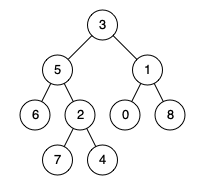给定一个二叉树, 找到该树中两个指定节点的最近公共祖先。
百度百科中最近公共祖先的定义为:“对于有根树 T 的两个节点 p、q,最近公共祖先表示为一个节点 x,满足 x 是 p、q 的祖先且 x 的深度尽可能大(一个节点也可以是它自己的祖先)。”
示例 1:

1
2
3
| 输入:root = [3,5,1,6,2,0,8,null,null,7,4], p = 5, q = 1
输出:3
解释:节点 5 和节点 1 的最近公共祖先是节点 3 。
|
示例 2:

1
2
3
| 输入:root = [3,5,1,6,2,0,8,null,null,7,4], p = 5, q = 4
输出:5
解释:节点 5 和节点 4 的最近公共祖先是节点 5 。因为根据定义最近公共祖先节点可以为节点本身。
|
示例 3:
1
2
| 输入:root = [1,2], p = 1, q = 2
输出:1
|
提示:
- 树中节点数目在范围
[2, 105] 内。
-109 <= Node.val <= 109- 所有
Node.val 互不相同 。
p != qp 和 q 均存在于给定的二叉树中。
情况一

情况二

递归法
1
2
3
4
5
6
7
8
9
10
11
12
13
14
15
16
17
18
19
20
21
| class Solution {
public TreeNode lowestCommonAncestor(TreeNode root, TreeNode p, TreeNode q) {
if(root == null) return null;
if(root == p || root == q){
return root;
}
TreeNode left = lowestCommonAncestor(root.left, p, q);
TreeNode right = lowestCommonAncestor(root.right, p, q);
if(left == null && right == null){
return null;
}else if(left != null && right == null){
return left;
}else if(left == null && right != null){
return right;
}else{
return root;
}
}
}
|



